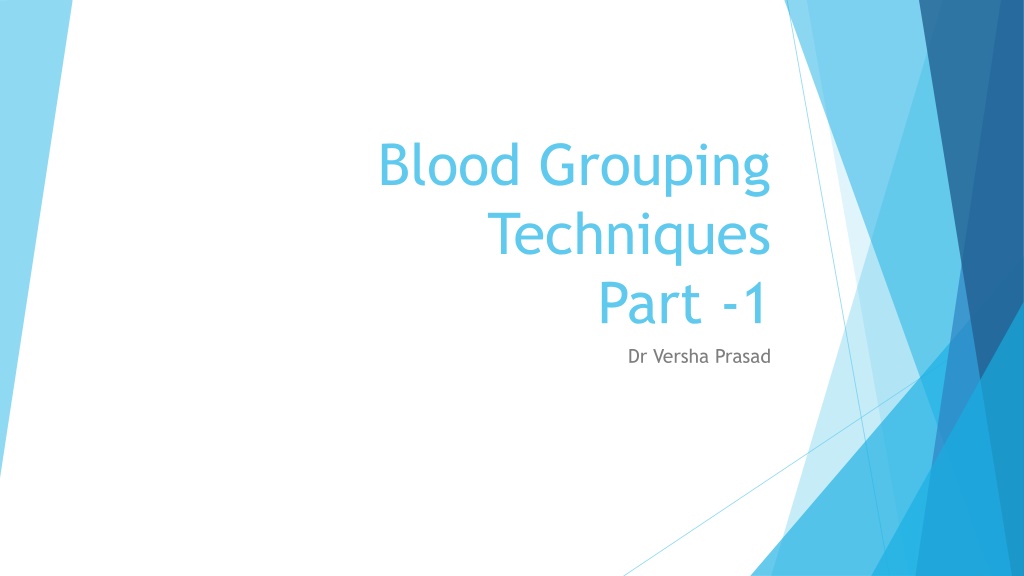Blood Grouping Techniques: Methods and Advantages
Various blood grouping techniques including slide or tile method and microplate technique are discussed. Advantages of microplate ABO grouping such as cost-effectiveness, automation potential, and reduction in errors are highlighted. The use of different manual methods and newer techniques in blood grouping is explained in detail.
Download Presentation

Please find below an Image/Link to download the presentation.
The content on the website is provided AS IS for your information and personal use only. It may not be sold, licensed, or shared on other websites without obtaining consent from the author. Download presentation by click this link. If you encounter any issues during the download, it is possible that the publisher has removed the file from their server.
E N D
Presentation Transcript
Blood Grouping Techniques Part -1 Dr Versha Prasad
B GROUPING AND SUBGROUPING Three manual methods can be used when performing blood grouping 1.Glass slide or white porcelain tile 2.Glass test tube 3.Microwell plate or microplate Newer techniques Column technique (sephadexgel) Solid phase tests
Slide or Tile Method This technique may be used for emergency ABO grouping tests or for preliminary grouping particularly in an outdoor camp Slide or tile testing is not recommended for routine use because it is not reliable for weakly reactive antigens on cells serum grouping with low titre anti A or anti B Disadvantages Less sensitive than the tube test Drying up of the reaction mixture can cause aggregation of cells giving false positive results Weaker reactions are difficult to interpret
Microplate Technique Microwell plate consists of a small tray with 96 small wells each of which can hold about 200 300u1 of reagent. Microplate technology is gaining widespread popularity due to increasing workload in blood transfusion laboratories and recent availability of packaged automated system. Three types of microplates are available a.U type well b.V type well c.Flat bottom The U type well is generally used in red cell serological work as it is easier to read the results in U bottom plates.
Advantage of microplate ABO Grouping 1. Small volumes and low concentration of sera and red cells are used, making it cost effective 2. Easy handling of a microplate, which can replace 96 test tubes. 3. Batching of samples can be achieved with considerable economy in space and time. 4. If larger laboratories acquire microplate hardware items e.g. reagent dispenser, sample handler and cell washer it may further reduce the operation time. 5. Large batches of plates can be predispensed with antisera and reagent red cells before testing. 6. The technique of microplate grouping may be automated by on line data capture in larger laboratories, which may help in a) reduction in reading and transcription errors b) saving in staff time c) use of bar codes for samples and microplate identification
Advantage of microplate ABO Grouping 6. The technique of microplate grouping may be automated by on line data capture in larger laboratories, which may help in a) reduction in reading and transcription errors b) saving in staff time c) use of bar codes for samples and microplate identification d) integration into a comprehensive computer system for storage of data.
Tube Method: Advantage of tube Method Test tubes either of glass or plastic may be used. The tube technique is more sensitive than slide technique for ABO grouping. Advantage It allows for fairly long incubation without drying up of the tubes contents. Centrifugation involved enhances the reaction allowing weaker antigens and antibodies to be detected. Simplicity of reading and grading of results . Clean and more hygienic. Requires smaller volume of reagents More sensitive than slide technique
GROUPING BY TUBE METHOD Samples CPDA anti coagulated Blood samples collected from any source. Reagents required for tube method Working standardised Monoclonal antisera (Anti A, Anti B,Anti A,B) Anti A1 (Lectin) & Anti H (Lectin) Reagent cells (A cells, B cells and O cells), 3% in Normal Saline. Test red cells Samples from IRCS Normal Saline (0.9%)
Processing of blood samples Separation of RBC & Plasma Allow all reagents to come to Room Temperature Identify reagents RBC / blood samples to be used for reverse grouping Fill in proforma. Processing Centrifuge at 1000 rpm for 1 min at R.T using clean pipette tip, aspirate plasma gently without disturbing settled cells and transfer to a labeled clean test tube for reverse grouping
Preparation of cell Suspension Label the tubes as per S.No . of samples Add 1ml whole blood in respective S.No . of tubes and Normal saline (N.S) 8 ml, mix well. Centrifuge at 2500 rpm for 3 min at R.T Aspirate supernatant & discard Wash 3 times as above till supernatant is clear. Consider cell pellet as 100% Prepare 3%red cells suspension in normal saline

 undefined
undefined
























